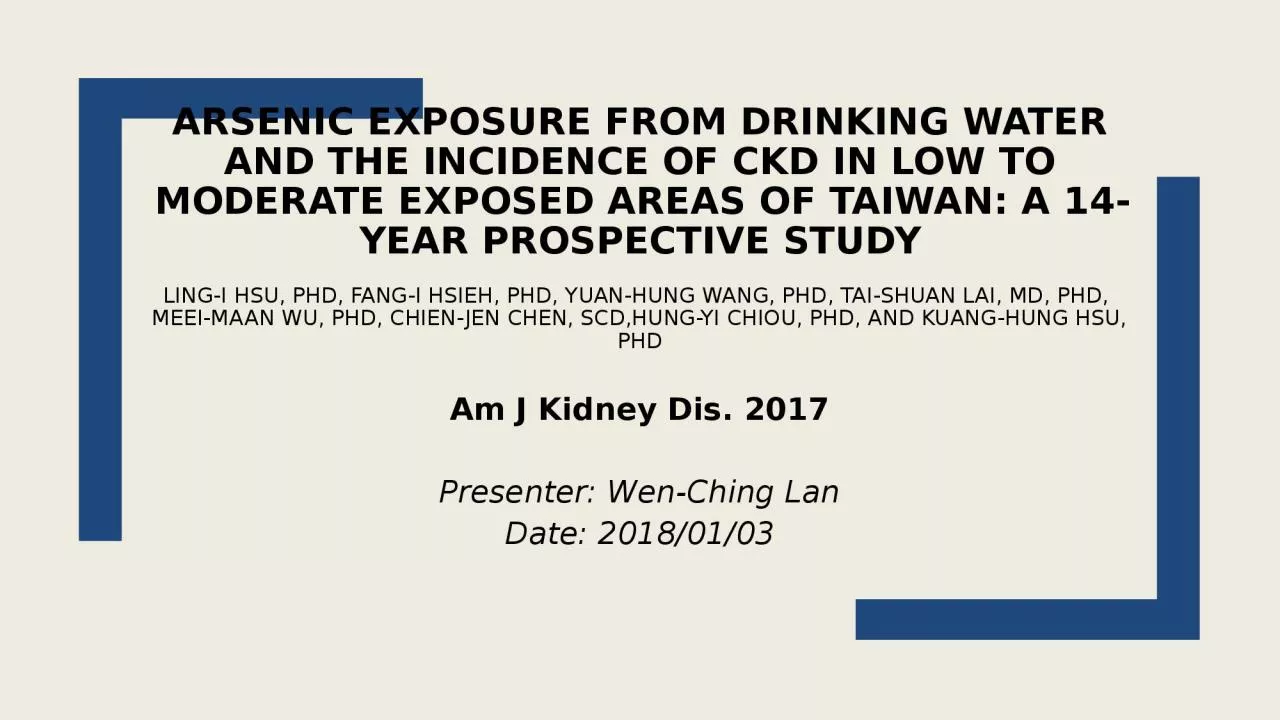

CKD in Low to Moderate Exposed Areas of Taiwan A 14Year Prospective Study LingI Hsu PhD FangI Hsieh PhD YuanHung Wang PhD Tai Shuan Lai MD PhD MeeiMaan Wu PhD Chien ID: 1037657
Download Presentation The PPT/PDF document "Arsenic Exposure From Drinking Water and..." is the property of its rightful owner. Permission is granted to download and print the materials on this web site for personal, non-commercial use only, and to display it on your personal computer provided you do not modify the materials and that you retain all copyright notices contained in the materials. By downloading content from our website, you accept the terms of this agreement.
1. Arsenic Exposure From Drinking Water and the Incidence of CKD in Low to Moderate Exposed Areas of Taiwan: A 14-Year Prospective StudyLing-I Hsu, PhD, Fang-I Hsieh, PhD, Yuan-Hung Wang, PhD, Tai-Shuan Lai, MD, PhD, Meei-Maan Wu, PhD, Chien-Jen Chen, ScD,Hung-Yi Chiou, PhD, and Kuang-Hung Hsu, PhDAm J Kidney Dis. 2017Presenter: Wen-Ching LanDate: 2018/01/03
2. Arsenic exposure is an important public health issue worldwide.Long-term arsenic ingestion may have adverse health effects, including diabetes, hypertension, cataracts, vascular diseases, and various cancers. Acute arsenic poisoning may cause kidney damage, including acute kidney injury.The pattern of the association between low-level exposure and adverse kidney outcomes needs to be explored.1
3. We investigated the dose-response relationship between low to moderate arsenic exposure from drinking water and chronic kidney disease (CKD) via a prospective study in northeastern Taiwan.In addition, we evaluated the disease modification effects of risk factors, including diabetes and hypertension.2
4. METHODSStudy PopulationThe cohort was recruited from 18 villages in the Lanyang Basin of northeastern Taiwan during 1991 to 1994, and 6,093 residents 40 years or older were recruited.Sociodemographic characteristics, occupational history, and lifestyle variables of the study population were obtained at baseline using a structured questionnaire. 3
5. METHODSArsenic Exposure Assessment3,901 well-water samples (1 sample from each household) were collected.Cumulative arsenic exposure was defined as (household well-water arsenic concentration) * (duration of well-water consumption).Overall, 14% of participants had unknown exposures.4
6. METHODSIdentification of Kidney Diseases, Diabetes, Hypertension, and HyperlipidemiaCohort participants who died before 1998, those who had no well arsenic concentrations available, and those with prevalent kidney diseases (diagnosed before March 1, 1998) were excluded. → 6,093 participantsParticipants with 3 or more outpatient visits or 1 or more hospitalized record or 1 or more catastrophic illness record for kidney diseases and CKD. kidney diseases(ICD-9:250.4, 274.1, 283.11, 403.* 1, 404.* 2, 404.* 3, 440.1, 442.1, 447.3, 580-589)、CKD(ICD-9:585)DM: 3 or more outpatient visits or with at least 1 hospitalization and having an ICD-9 diagnosis at a discharge. DM (ICD-9:250, 357.2, 362.0, or 366.41)Hypertension: 3 or more monthly packs of antihypertensive HT(ICD-9: 362.11, 401 - 405, or 437.2)Dyslipidemia: 3 or more monthly packs of antihyperlipidemia Dyslipidemia (ICD-9: 272)5
7. METHODSUrinary Arsenic MetabolitesFirst-morning spot urine samples were collected in 1991 to 1994, frozen within 2 to 3 hours of collection, and stored at -20 C. Participants were asked not to consume seafood for the 3 days before urine collection. We calculated the sum of inorganic and methylated arsenic species, which is defined as urinary total arsenic, and concentrations were divided by urine creatinine concentration to account for urine.A total of 1,658 urinary arsenic profiles were measured and used to analyze the cross-sectional association with proteinuria.6
8. METHODSUrine Protein-Creatinine RatioUrine creatinine was measured using the Jaffé kinetic assay (Beckman). Urine protein was measured by terminal colorimetric analysis (Beckman). Protein concentration was divided by urine creatinine concentration to account for urine dilution. We defined urine protein-creatinine ratio >= 200 mg/g as proteinuria based on standard guidelines.7
9. METHODSStatistical AnalysisThe primary outcome was incident kidney disease cases and CKD.Participants’ follow-up years were calculated from the beginning of the study (January 1, 1998) to the date of disease diagnosis, death, or end of the study (December 31, 2011), whichever came first.Covariates: including age, sex, education, BMI, cigarette smoking, alcohol drinking, and duration of regular analgesic useCox regression analysisTime-dependent disease statusStratified analysesSensitivity analysis8
10. METHODSFigure 1. Sample consort diagram9
11. RESULTS10
12. RESULTS11
13. RESULTS12
14. RESULTSFigure 3. The cumulative incidence of chronic kidney disease (CKD) by well-water arsenic concentration (#10.0, 10.1-49.9, 50.0- 149.9, and $150.0 mg/L) for (A) male and (B) female participants in northeastern Taiwan, 1998 to 2011. X-axis: Follow-up years. Yaxis: Adjusted cumulative hazard of developing CKD.13
15. RESULTS14
16. DISCUSSIONThe findings are consistent with previous studies in Taiwan and Bangladesh suggesting no significantly interactive effect between arsenic exposure and diabetes on CKD. a decreasing trend of kidney disease mortality after stopping arsenic exposure among residents in arseniasis-endemic areas.The present study shows that women may be more susceptible to arsenic exposure in terms of developing CKD. 15
17. DISCUSSIONLimitationKidney diseases and CKD outcomes were based on diagnostic codes. Glomerular filtration rates were not available. Other heavy metals were not measured.Using a broad category of kidney diseases or CKD may underestimate the strength of the association with specific causes.We assessed arsenic levels only once and assumed that well-water concentrations were constant over decades.16
18. DISCUSSIONStrengthThis is the first prospective study with a large sample size to explore the dose-response relationship between low to moderate arsenic exposure from drinking water and kidney diseases. The comprehensiveness and completeness of disease status follow-up, including diabetes, hypertension, dyslipidemia, and kidney diseases, were obtained from the NHI data set using well-defined criteria.The data source is likely to be accurate and reliable because Taiwan NHI has covered >99% of the population.17
19. ConclusionsThis study describes the temporal relationship between arsenic concentrations >= 10 mg/L in drinking water and CKD. A dose-dependent association between well-water arsenic concentration and kidney diseases was observed. Higher creatinine-adjusted urinary total arsenic concentrations were associated with a higher prevalence of proteinuria.18
20. Thanks for listening.